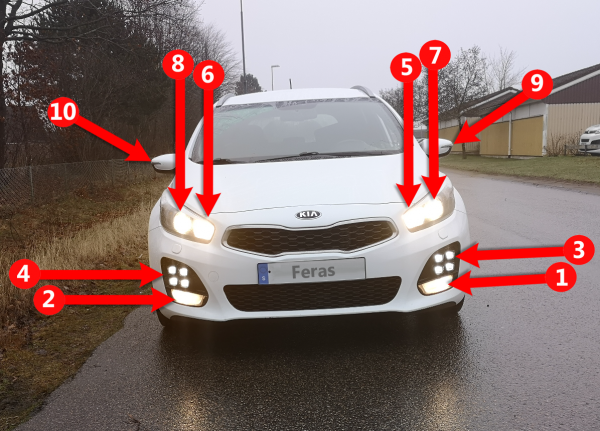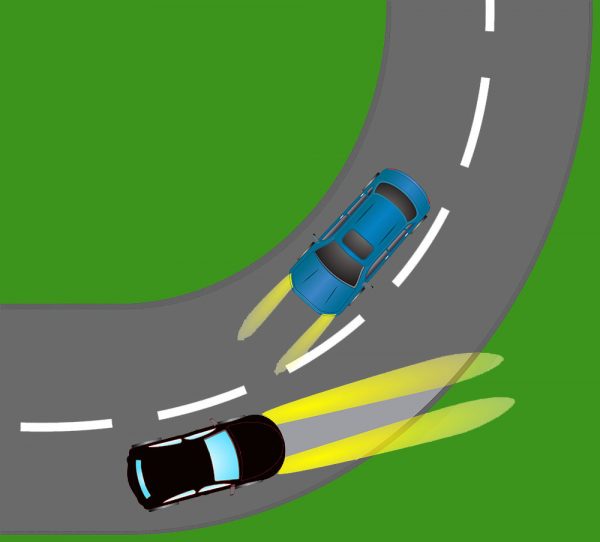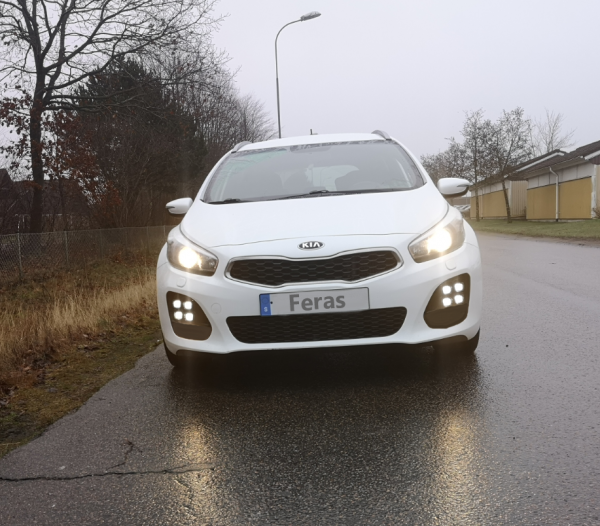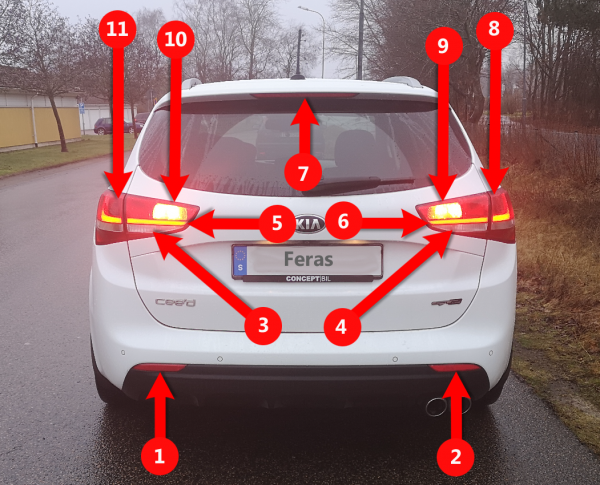It is important for you as a driver to know the car lights, when to use them, and when you should not use some lights in the car
On this page, I will explain in pictures and detail about front and rear car lights and when to use them.
First, I will talk about driving in the dark
Driving in the dark is double the danger, as you cannot detect the danger early, for example
If you are driving during the day and there is an animal on the road or a car parked next to the road, you will be able to
Watch them from a good distance and you can avoid danger in the best way.
If you drive at night, you will not be able to see and detect the danger early if there is an animal on the road
You may collide with it due to poor visibility in the dark and on the side of the road where there is not enough distance to react
This makes driving in the dark dangerous and you must be careful when driving in the dark.
Explanation of car lights

- The lights at number 1 and 2 are fog lights
- The lights at numbers 3 and 4 are automatic lights that cannot be turned off and are found in modern cars
- The lights at number 5 and 6 are high beam
- Lights at numbers 7 and 8: normal/low/corner/low light
- The lights at numbers 9 and 10 are the indicator lights on the side mirrors
We come to the explanation now
Fog lights: You have the right to use them during heavy fog
- Normal light with fog light is prohibited
- Normal light with notification light is prohibited
- Normal light with high beam is prohibited
- Fog light with warning light is prohibited
Automatic lights
The automatic lights in the car cannot be turned off, as they are in modern cars
You can drive in it without turning on any other lights, only during the day.
High beam
High beams when used in the presence of cars coming from the opposite direction can cause a real problem
The driver on the opposite side cannot see clearly because of the high beams that dazzle his eyes
This may cause an accident, so you should not use high beams if there is oncoming traffic
Or during your encounter with a bike, because it will dazzle the biker and expose him to great danger.
You can use high beams if there are pedestrians because pedestrians may not look at the light
Or they put their hands over their eyes so as not to be startled, unlike a cyclist.
It is good to use high beams during darkness because it will show you the road better and for greater distances
However, it should not be used during heavy fog or during heavy snowfall
It makes vision worse and you cannot benefit from it.
You should not use high beams when driving behind a vehicle because the light will dazzle the driver in front of you
Through its internal mirror in the middle
Also, high beams should not be used when the street is well lit or during daylight.
If you are driving in the dark and encounter a car using high beams, focus your eyes on the right side of the road
Until you pass the car so that you are not dazzled by the strength of the light directed towards your eyes.
You can use the high beams for as long as possible when cornering, because the high beams do not go directly to the oncoming car.
Example

When you meet a car coming from the other side after turning off the high beams, you can return to it directly when meeting.
Example

When meeting, it means that when the front of your car becomes at the same level as the front of the other car
You can turn on the high beams again because the light will not dazzle the driver if you passed it
Bright/low/normal/low light
It is the permissible light that you must drive your car with in normal conditions and during the day
If your car is not equipped with default lights that turn on automatically, which is the light used in cars that does not dazzle others
The natural operating lights of the car are shown in the following picture

In the picture above, you can see the normal light working and the basic lights also working, and this situation is normal.
There is also a light on each side mirror, which is a blinking light that adds an orange color when the blinkers or four-way lights are on.
Car tail lights

- Numbers 1 and 2 are red reflectors
- Numbers 3 and 4, the car’s dimples, light up in orange
- Numbers 5 and 6 The parking light must be turned on in the dark
- Number 7 is a red light that turns on while reversing
- No. 8 and 11 brake lights
- No. 9 and 10 fog lights
The lights available in the entire car are as follows:
Four-way warning light
The warning light must be used when stopping for an emergency, etc.
All lights flash alternately at the same time when the quad light is activated
It is activated by the button ![]() In the car
In the car
You have the right to turn on the warning lights in the towed vehicle, but you are not obligated to do so.
Fog light
The front fog light is stronger than the regular light, which is why it is of great benefit during fog.
You have the right to use the fog light instead of the regular light in the event of a malfunction in the regular light
But you do not have the right to use regular light and fog light together.
Rear fog light
The rear fog light is used to help cars behind you see you clearly if visibility is very poor.
The rear fog light dazzles drivers behind you, as it has a very strong light and should not be used without fog.
High beam/floodlight
A spotlight can be installed on the car to enhance the high beam
But you do not have the right to use high beams with normal beams.
Stand light
You must use parking lights when you park in an inappropriate place
Or on the edge of the road in the dark or in dark parking lots so that cars can see you well.
taillight
There are two red lights that turn on automatically.
Brake light
Brake lights turn on when you press the brake pedal, and they are bright lights.
Reverse light
The reversing light is a white light that turns on automatically when reversing the car.
Registration plate lights
Two white lights above the car’s number plate light up automatically.
You can detect things when driving at night using lights in the following order
Dark clothing without light reflectors
- Normal light: 25 meters
- High beam: 150 meters
Bright clothes without light reflectors
- Normal light: 60 meters
- High beam: 300 meters
Clothes with reflective lights
- Normal light: 125 meters
- High beam: 450 meters
